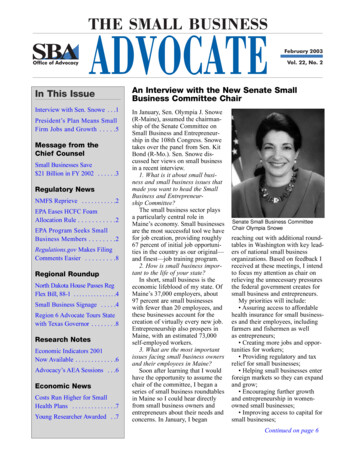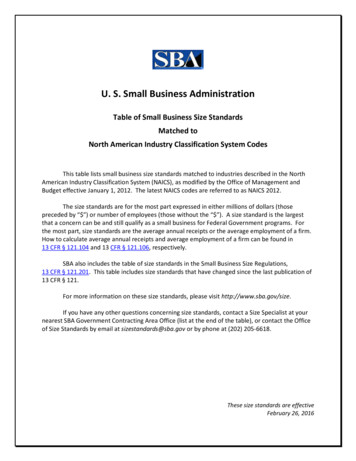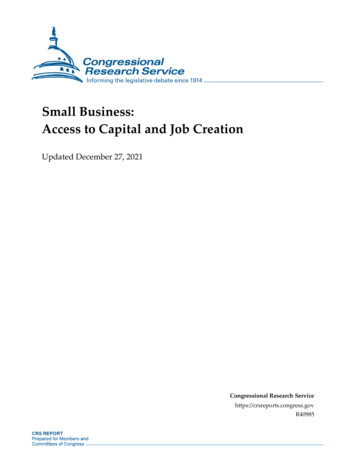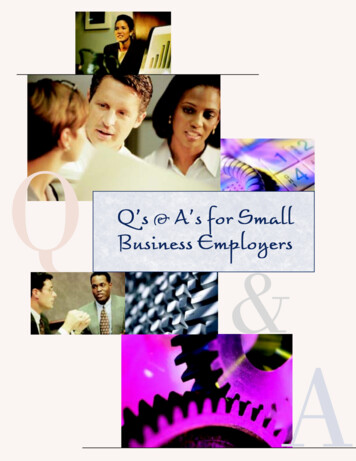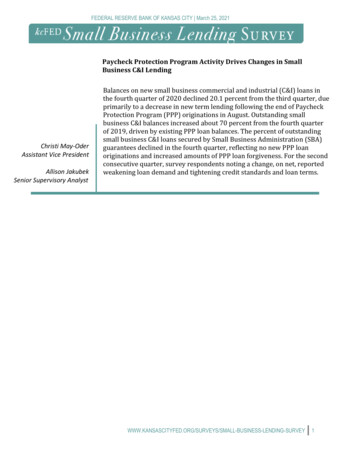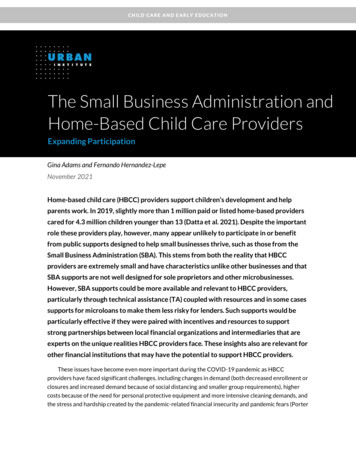
Transcription
CHILD CARE AND EARLY EDUCATIONThe Small Business Administration andHome-Based Child Care ProvidersExpanding ParticipationGina Adams and Fernando Hernandez-LepeNovember 2021Home-based child care (HBCC) providers support children’s development and helpparents work. In 2019, slightly more than 1 million paid or listed home-based providerscared for 4.3 million children younger than 13 (Datta et al. 2021). Despite the importantrole these providers play, however, many appear unlikely to participate in or benefitfrom public supports designed to help small businesses thrive, such as those from theSmall Business Administration (SBA). This stems from both the reality that HBCCproviders are extremely small and have characteristics unlike other businesses and thatSBA supports are not well designed for sole proprietors and other microbusinesses.However, SBA supports could be more available and relevant to HBCC providers,particularly through technical assistance (TA) coupled with resources and in some casessupports for microloans to make them less risky for lenders. Such supports would beparticularly effective if they were paired with incentives and resources to supportstrong partnerships between local financial organizations and intermediaries that areexperts on the unique realities HBCC providers face. These insights also are relevant forother financial institutions that may have the potential to support HBCC providers.These issues have become even more important during the COVID-19 pandemic as HBCCproviders have faced significant challenges, including changes in demand (both decreased enrollment orclosures and increased demand because of social distancing and smaller group requirements), highercosts because of the need for personal protective equipment and more intensive cleaning demands, andthe stress and hardship created by the pandemic-related financial insecurity and pandemic fears (Porter
et al. 2020). 1 The potential loss of HBCC providers is particularly problematic because families haveincreasingly turned to HBCC options during the pandemic, 2 and a robust supply of HBCC providers islikely essential to helping parents get back to work. Further, as we describe in more detail later,problems with the initial round of Paycheck Protection Program (PPP) loans, intended to give relief tosmall businesses, provided important insights into the ways that SBA loans and financial supports arenot well designed for very small businesses (Ullrich 2020), which we often refer to in this brief as“microbusinesses” or sole proprietors. 3Building on the knowledge gained from these problems and the opportunities available from therecent allocation of 50 billion in new funding for child care through the pandemic relief fundingpackages, 4 states have a unique opportunity to invest in strategies that better support HBCC providers’financial health and well-being. Further, the challenges faced by the PPP loan program highlighteduseful lessons that the SBA could apply to their existing efforts to support microbusinesses such asHBCC providers.Based on expert interviews 5 and a review of the literature, this brief provides an overview of thecharacteristics of HBCC providers that make accessing traditional financial supports unusuallychallenging for them, an overview of parts of the SBA’s services that could be relevant to HBCCproviders, and steps that could be taken to help expand the extent to which HBCC providers can benefitfrom SBA supports. It also briefly explores areas where we need more information and discusses theimplications of these findings for other financial entities that support small businesses. Box 1summarizes the major findings. This brief is one of a series focusing on HBCC providers’ participation infederal programs and services. 6BOX 1Key Takeaways: Factors That Shape the Relevance of SBA Supports for Home-Based Child CareProviders and Suggested PoliciesDespite the importance of home-based child care providers, many appear unlikely to participate in orbenefit from programs designed to help small businesses thrive, such as supports provided by the SmallBusiness Administration. A review of barriers that keep HBCC providers from benefiting from SBAfinancial supports suggests that unique characteristics of HBCC providers and the SBA’s orientation arefactors. However, SBA supports can be more accessible and relevant to HBCC providers.Unique Characteristics of HBCC ProvidersHBCC providers can benefit from various financial education and support activities, yet they haveseveral characteristics that make accessing SBA supports challenging for them. Among them are thatHCBB providers may not see themselves as a “business”; differ from other small businesses in ways that can make loans less appropriate and riskier forthem and for lenders; may be unaware of financial resources or find sorting through options a challenge;2HBCC PROVIDERS AND THE SBA
can be more challenging than other child care providers for financial institutions to work with ifthey are unfamiliar with basic business and accounting practices and lack prior relationships withfinancial institutions; may not receive fair treatment or may not have had good experiences with financial orgovernment institutions; and may have unusually complex finances.In addition, HBCC providers are heterogenous and vary significantly across a range ofcharacteristics.Relevant Supports from the Small Business AdministrationThe SBA supports small businesses by enhancing access to capital, providing loans, and providingtechnical and managerial assistance, among other activities. However, three contextual issues areimportant to understand when considering the role the SBA plays for HBCC providers: The SBA is only one of many sources of financial and technical assistance to small businesses, andthe ecosystem of these supports varies widely from one community to another. SBA activities may not be visible to HBCC providers because supports are distributed throughlocal financial institutions or community organizations, rather than directly from the SBA. The SBA’s orientation is generally not toward microbusinesses like HBCC providers.Although no data are available on whether and how SBA activities support HBCC providers, thetwo SBA activities that are most relevant to HBCC providers are the following: The SBA Microloan Program loans funds to intermediary organizations, which then provide lowinterest loans of up to 50,000 to small businesses to help them launch or expand. The SBA doesnot subsidize or guarantee the microloans provided by the intermediary lenders. The SBA supports technical assistance on financial management and business operationsthrough local partners and community development financial institutions, including SmallBusiness Development Centers, Women’s Business Centers, and organizations that participateas microlenders in the SBA’s Microloan Program.The Potential of Intermediary OrganizationsOur review suggests that it would be valuable to explore the role of supporting specializedintermediaries that could facilitate stronger relationships between HBCC providers and financialinstitutions. These intermediaries should be entities that understand the HBCC industry and providers’financial realities and can support them appropriately.Suggestions for ActionPossible policy actions, both within the SBA and more broadly across the ecosystem of supports forsmall businesses, could help HBCC providers access financial supports.The following are some suggestions for action at the federal level: Explore mechanisms to make SBA-supported microloans less risky for the lender. Consider ways that the SBA can more effectively support microbusinesses and people who areself-employed but are unlikely to expand their businesses. Explore expanding SBA (or similar) TA supports to a more diverse set of TA providers, andsupport partnerships between SBA-affiliated organizations and specialized HBCCintermediaries.HBCC PROVIDERS AND THE SBA3
Other actions could be taken at the federal level (through the SBA or other agencies) or at the statelevel with state funding: Explore strategies to combine SBA-like microloans or TA with grants, or consider alternativemechanisms to expand the financial resources and supports available to HBCC providers. Designate financial supports that can be coupled with supportive TA and credit enhancement forHBCC providers.Understanding the HBCC Provider ContextTo understand the SBA’s role for HBCC providers, it is important to better understand HBCCproviders—specifically, what we know about these providers, what financial supports they need, andwhat characteristics may affect their ability to get financial supports from the SBA.Who Are HBCC Providers?Among the more than 1 million listed and paid home-based providers that cared for 4.3 million childrenyounger than 13 in 2019 were 91,200 providers that are listed with a public agency and assumed to belicensed or regulated in some way (or “licensed HBCC”) and an additional 1.05 million paid HBCCproviders that are not listed with any agency (or “unlicensed HBCC”) (Datta et al. 2021). See box 2 forthe terminology we use to talk about different parts of the HBCC sector.HBCC providers play a crucial role in caring for children in the US and are particularly likely to carefor infants and toddlers, children in rural areas, and children whose families work nontraditional hours.Despite their important role, these providers are less likely than child care centers to participate in andbenefit from public child care investments. 7 As is described in more detail later, they also are likely tohave relatively low earnings.In this brief, we focus primarily on listed and paid unlisted providers, because those caring forchildren without charging for the care seem unlikely to be interested in seeking business resources orTA for financial management for that care.BOX 2Home-Based Child Care Provider TerminologyThe home-based child care field has many terms to refer to HBCC, including “informal care,” “familyfriend and neighbor care,” “family child care,” “license-exempt care,” and “relative care.”a For ouranalysis, we differentiate between (1) licensed family child care and (2) home-based child care settingsthat are legally exempt from state or local licensing, which includes relative home-based care and(depending on the state) some nonrelative home-based child care.When possible, we distinguish between licensed and unlicensed care and relative and nonrelativecare because in many states these criteria shape licensing status, which can be a gateway to public4HBCC PROVIDERS AND THE SBA
supports. But we recognize the heterogeneity within these categories and that even these categoriesare not consistently used—for example, some states distinguish between care in the child’s home andcare in someone else’s home. Also, sometimes we are limited by the definitions used by our datasources, which may differ from our terminology. When possible, we clarify differences.aSarah Haight, “Family Prosperity: 10 Minutes with a Leading Early Childhood Researcher on Home-Based Care andOpportunities Ahead,” Ascend at the Aspen Institute, November 9, 2020, at Financial Supports Do HBCC Providers Need?Our interviews suggested that HBCC providers could benefit from basic forms of financial educationand supports, including the following: Financial and business skills training. HBCC finances can be complex and may require financialknowledge and skills that HBCC providers do not have. One family child care business expertsuggested that HBCC providers’ financial knowledge and skill needs fall into the five categoriesof recordkeeping and taxes, contracts and policies, legal and insurance, marketing, and moneymanagement and retirement. Funds for equipment, facility upgrades, and other program needs. HBCC providers may needfunds at various stages of their business operations, including to start up, renovate, or improvetheir homes to meet licensing requirements; expand to serve more children or to change theirbusiness model (such as serving a different age group); make improvements to allow them toparticipate in public systems such as Head Start or state prekindergarten; allow them torecover from a crisis (e.g., caused by a natural disaster or illness); and address cash flowchallenges that exist because of irregularity of payments from parents or public systems.The heterogeneity of the HBCC provider community means that these needs will look differentfrom one provider to another. A grandparent or family friend who is caring for children because ofpersonal relationships might benefit most from supports that focus on personal finances, moneymanagement, or retirement, while a family child care provider opening her home to care for eightchildren with an assistant could benefit from all the topics mentioned here.HBCC Provider Characteristics That Affect Access to Financial SupportsA review of paid HBCC providers’ characteristics from the 2012 National Survey of Early Care andEducation (NSECE) suggests these providers differ in many ways from traditional small businesses,which are the focus of the SBA’s financial and business support mechanisms. Many of thesecharacteristics can prevent HBCC providers from fully benefiting from the SBA supports. Some of thesecharacteristics are that HBCC providers may not see themselves as a “business”;HBCC PROVIDERS AND THE SBA5
differ from other small businesses in ways that can make loans less appropriate and riskier for them and for lenders; may be unaware of financial resources or find sorting through options a challenge; can be challenging for financial institutions to work with if they are unfamiliar with basicbusiness and accounting practices and lack prior relationships with financial institutions;may not receive fair treatment or may not have had good experiences with financial or government institutions; andmay have unusually complex finances. In addition, HBCC providers are heterogenous and vary significantly across a range ofcharacteristics, including the number of children they serve, whether a provider works alone or hasassistants, licensing status, motivation, location, finances, and more. Some of these characteristics canbe based on the different policy contexts that exist across states. 8HBCC PROVIDERS MAY NOT SEE THEMSELVES AS A BUSINESSA common theme across our interviews with child care financial experts is that HBCC providers oftendo not perceive themselves as running a business. Although no data exist on this exact question, theNSECE asked several related questions that corroborate this perspective, with some apparent variationbetween HBCC providers that are listed and those that are paid but not listed.Data from the 2019 NSECE indicate the following:HBCC providers seldom identify earning money as a primary reason for caring for children. Only 5 percent of listed and 12 percent of unlisted paid providers report this as their primaryreason.The majority of HBCC providers do not see caring for children as a career or personal calling, with some variation between those who are listed and those who are paid but not listed. Slightlymore than half of listed home-based providers (53 percent) report that a personal career orcalling was their primary reason for looking after children, compared with about a fifth (21percent) of unlisted paid HBCC providers.In contrast, slightly more than half of unlisted paid providers (55 percent) report helping the children’s parents as their primary reason for looking after children. Only 16 percent of listedproviders report this as the reason for providing care.The experts we interviewed agreed that many HBCC providers do not see themselves as operatinga business or as being entrepreneurs and suggested that this was one of the initial struggles thatorganizations working to support HBCC providers’ financial practices and resources have to overcome.6HBCC PROVIDERS AND THE SBA
HBCC PROVIDERS DIFFER FROM OTHER SMALL BUSINESSES IN WAYS THAT CAN MAKE LOANSLESS APPROPRIATE AND RISKIER FOR THEM AND FOR LENDERSOur review suggests that HBCC providers are different from other small businesses in ways that createchallenges both for them and financial institutions. Specifically, paid HBCC providers operate their businesses out of their homes; may not own their homes and have relatively little collateral; may have unstable housing situations or face rising housing costs that could force them to move(First Children’s Finance 2021); often have relatively low incomes; 9 have low profit margins and fluctuating revenues (First Children’s Finance 2021); may not consider making a profit a personal or professional goal; 10 are often run by women and people of color, who have historically been marginalized fromlending and banking systems; 11 may not be able to grow or expand their business because of market limitations on their abilityto raise prices and constraints on their ability to serve more children; 12 are very small, usually working alone or with a paid assistant, 13 and function more like selfemployed individuals or “microbusinesses,” rather than “small businesses,” which can be muchlarger; 14 and vary in how long they expect to care for children, with more than a third of unlisted HBCCproviders expecting to care for children fewer than 5 years, which likely affects their interestand willingness to take on debt, for example, or to make significant efforts to improve theirbusiness. 15In part because of these factors, a recent report found that bankers do not understand the childcare industry and perceive it as a risky investment (First Children’s Finance 2021).HBCC PROVIDERS MAY BE UNAWARE OF FINANCIAL RESOURCESA recent report suggests that child care providers can be unfamiliar with the financial options availableto them and can find it difficult to sort through and compare options to identify the most appropriate fortheir situation (First Children’s Finance 2021).THE RELATIONSHIP BETWEEN HBCC PROVIDERS AND FINANCIAL INSTITUTIONS MAY BECHALLENGINGOur respondents suggested that HBCC providers may be challenging for financial institutions to workwith in several ways. For example, our respondents suggested that HBCC providers tend not to engagein basic financial business practices such as keeping careful financial records, having a separate businessbank account, having payroll or data systems, and having relationships with accountants or financialinstitutions. HBCC providers may also lack documentation that financial institutions regularly request,HBCC PROVIDERS AND THE SBA7
such as business plans or profit/loss tax forms (Schedule C). Several of these issues became evidentduring the first round of PPP loans (box 3). One expert suggested that financial institutions may not seeHBCC providers as businesses, which undercuts HBCC providers’ ability to be taken seriously whenseeking financial supports.In addition, some of our respondents suggested that HBCC providers whose primary language isnot English or are immigrants may face extra barriers to accessing financial supports. Although HBCCproviders with these characteristics appear to be a subset of all HBCC providers, the 2012 NSECEfound that HBCC providers are more likely than staff at child care centers to speak languages otherthan English with the children in their care (19 percent versus 9 percent) and to have been born inanother country (17 percent versus 11 percent) (Paschall, Madill, and Halle 2020). In addition tolanguage barriers that some HBCC providers may face when interacting with financial institutions,cultural differences may also hinder HBCC providers in dealing with financial institutions. These mayinclude distrust of financial institutions because of experiences in their countries of origin, differences inmoney management practices, and other cultural nuances stemming from the diversity of HBCCproviders.Finally, respondents suggested the PPP loan process revealed that many small businesses (ingeneral—not specifically HBCC providers) may not be functioning in ways that fully conform with thelaw—for example, they may not be reporting their income to the Internal Revenue Service or may not bemeeting licensing requirements. In both cases, HBCC providers would face barriers to accessingsupport from financial institutions.HBCC PROVIDERS MAY NOT HAVE HAD GOOD EXPERIENCES WITH FINANCIAL ORGOVERNMENT INSTITUTIONSSome financial institutions’ policies and practices may create challenges and barriers that reduce HBCCproviders’ willingness to seek financial supports. For example, research suggests that communities ofcolor, people with immigrant statuses, and women can have bad experiences with financing institutions,some of which may have a history of structural racism and gender discrimination (Battisto et al. 2021;Goodman, Bai, and Li 2018; Singer and Paulson 2004). 16 Providers may also distrust entities affiliatedwith the government (Theodos and González-Hermoso 2019). This attitude can stem from personalexperiences or from what they have heard from others in their community.HBCC PROVIDERS MAY HAVE UNUSUALLY COMPLEX FINANCESOur respondents noted that the complexity of HBCC providers’ finances can present unique challengesfor financial institutions. This complexity appears in two ways:Providers’ professional and personal finances may be intertwined. For example, providers probably buy food or items for their program while they simultaneously buy food and items fortheir families. They also may hire family members.If providers receive resources from public programs such as the Child Care and Development Fund subsidy system or the Child and Adult Care Food Program, their finances can becomplicated to report because these resources may vary from month to month and are8HBCC PROVIDERS AND THE SBA
provided on a reimbursement or partial reimbursement basis. Receiving public resources issignificantly more common for listed or “licensed” HBCC providers than for unlisted providers:62 percent of the former report receiving public funds from some source in 2019, comparedwith 18 percent of the latter (Datta et al. 2021).BOX 3Insights from Home-Based Child Care Providers’ Experiences with the Paycheck Protection ProgramThe federal Paycheck Protection Program was designed to help small businesses recover from theeconomic downturn created by the COVID-19 pandemic by providing them with loans that wereforgivable under some circumstances. The Small Business Administration provided funds for theprogram, but financial institutions administered funds and approved loans. The problems that surfacedfor HBCC providers and other microbusinesses illustrate the disconnect between providers andmainstream financial institutions.a Among the problems were the following: The application process initially presumed that businesses had existing relationships with banks.This may explain why some home-based providers who did not receive a PPP loan reported thatbanks would not work with them. Many small businesses had not been documenting their finances appropriately or operatingunder basic business standards necessary for accessing the loans. The loans were initially based on a business’s profits, but child care providers who applied to theprogram may have made little or nothing in profits. The loans were then changed to be based ongross income. Paperwork requirements in the first round of the program were challenging for people who wereself-employed or had microbusinesses. For example, the application form asked for “an averagemonthly payroll,” a concept that people who are self-employed or have only one employee maynot be familiar with.aFor more information about home-based child care providers and the Paycheck Protection Program, see Copeland, Committeefor Economic Development, and All Our Kin (2020) and Ullrich (2020). See also Natalie Renew, “Home-Based Child CareProviders Need Improved Access to Federal Loans Now,” Home Grown, December 14, loans-now/; and LindaSmith, Kathlyn McHenry, Manami Suenaga, and Colby Thornton, “Child Care, Essential to Economic Recovery, Received Just 2.3Billion in PPP Funds during 2020,” Bipartisan Policy Center, March 9, 2021, -in-ppp-funds/.Exploring SBA Supports for HBCC ProvidersThe Small Business Administration is the only cabinet-level federal agency exclusively focused onsupporting small businesses. It does so by enhancing access to capital, lending directly to smallbusinesses during disasters, providing or facilitating equity investments, and providing technical andmanagerial assistance to small businesses, among other activities. 17HBCC PROVIDERS AND THE SBA9
Our respondents suggested that the two most relevant SBA activities for HBCC providers are theSBA’s Microloan Program and its supports for TA, each of which we describe in more detail later in thissection. (In addition, while less relevant to HBCC providers, the SBA facilitates larger loans—between 25,000 and 5.5 million depending on the loan type—for small businesses by guaranteeing a portion ofthe loans with community development financial institutions (CDFIs). We do not discuss these loanshere because they are much larger than most HBCC providers would need or be able to pay back.)Before examining these two activities more closely, we note a few overarching issues that are crucial tounderstanding the role that the SBA plays for HBCC providers. The SBA is only one of many sources of financial assistance and TA to small businesses, and theecosystem of these supports can vary widely from one community to another. These efforts canfocus on different sectors, different geographic areas or communities, and/or differentpopulations. Further, the funding for these efforts comes from various sources. On the federallevel, sources include the US Department of Housing and Urban Development’s CommunityDevelopment Block Grant Program, the US Department of Agriculture, and the US Departmentof Commerce’s Economic Development Administration. Various state, local, and private orphilanthropic entities also support these efforts. SBA activities operate through local financial institutions or community organizations, ratherthan directly from the agency to individual businesses. Specifically, most of the SBA’s financialfunctions are to facilitate lending and financial supports to small businesses by providing localbanks and other financial institutions with some protections from the financial risks of investingin small businesses, providing loans to intermediary organizations to make microloans, orhelping pay for TA provided by local organizations. As a result, support is not offered under theSBA name, so HBCC providers may not realize the SBA is facilitating the assistance theyreceive. Our experts agreed that the SBA’s orientation is generally not toward microbusinesses likeHBCC providers and that the lack of a reliable path toward fiscal solvency or financial growthamong those businesses can make supporting them a challenge for local lenders. Ourrespondents pointed out that the SBA provides services to help traditional small businesseswork toward financial solvency and business goals. This support can include, for example, TA tohelp business owners develop a marketing plan, including a plan for expansion, and start-uploans. Yet this approach may not be useful to HBCC providers who are unlikely to grow andwho may find paying back loans to be a challenge.The SBA Microloan ProgramThe SBA Microloan Program was designed to help very small businesses get low-interest loans of up to 50,000 to help them launch or grow and was intended to serve borrowers whose needs were not beingmet by the larger SBA loan programs. 18 Through this program, the SBA provides loans to communitydevelopment corporations, CDFIs, and other microlenders, and they in turn provide microloans to smallbusinesses.10HBCC PROVIDERS AND THE SBA
The intermediary organizations are community-based nonprofit organizations that can engage inlending and SBA-supported TA (described in more detail in the next section). They may specialize inworking with specific communities or types of businesses, and one of our respondents noted that theycan be engaged in a range of activities—such as supporting a business corridor or creating a businessincubator space—of which SBA resources and activities (including SBA microloans) may be only a part.Unlike the larger loans it makes, the SBA does not subsidize or guarantee the microloans providedby the intermediary lenders. Instead, the SBA loans the funds for the microloans to the intermediaryand provides separate funds to support TA related to the microloans. These loans, however, have highloss rates and because they are small, they are more expensive than larger loans for lenders tounderwrite. Our respondents suggested that the intermediary organizations may be more willing thantraditional financial institutions to accept higher loss rates because supporting the businesses receivingthe microloans is part of their mission and because they may have other resources to help offset thelosses (for example, from philanthropic sources).Nonetheless, our respondents agreed that the intermediaries must still focus on loans that perform.Microloans are often too small, not guaranteed, and risky in comparison with traditional loans. Also,traditional CDFIs are less likely to engage in microloans as they tend to make money by the differencebetween the cost and revenue of the loans. So making these loans more attractive to financialinstitutions could open more access to financ
Home-Based Child Care Provider Terminology . The home-based child care field has many terms to refer to HBCC, including "informal care," "family friend and neighbor care," "family child care," "license-exempt care," and "relative care."a For our analysis, we differentiate between (1) licensed family child care and (2) home .



